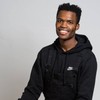Photo by Astrid Riecken / Stringer via Getty
When I imagine a what an environmental activist looks like, the first thing that comes to mind is a white dude with dreadlocks, a grizzly beard, tie-dye shirt, cargo pants, and flip-flops chained to a tree. I never gave much thought to someone who looked like me —a dark-skinned, queer person of color from a low-income community— having much of an investment in that kind of activism. But my preconceived notions were shattered after I attended the People's Climate March.On April 29, I joined tens of thousands of people in Washington D.C. for an event where demonstrators demanded the U.S. government, and the world, take action against the climate change crisis. It was a scorcher for late April, peaking at 90 degrees—the hottest temperature on record for D.C. at this time of year. The only thing more intense than the heat was the sense of urgency from the masses. Faith-based groups, indigenous nations, labor unions, and community groups gathered together to resist the administration's efforts to divide the country over a problem that affects us all.Prior to this event, I considered myself well-informed on climate change issues, but I didn't know about the intersection of identity politics and environmental activism. The march was about civil rights as much as it was about science. But, if I'm being completely honest with myself, I didn't feel like I personally had much at stake when it comes to climate change.The conversation around global warming now seems a bit passé, and I sure I'm not the only one who has begun to experience apocalypse fatigue. Though it's hard to admit, I could empathize with climate change deniers because the impact didn't seem to personally affect me. Although melting ice caps and bleached coral reefs are important climate issues, they're far removed from what I may experience on a day-to-day basis.Also, my idea of an environmentalist made me feel excluded from the movement. I care about nature, but not in the granola-crunching, Birkenstocks-wearing, "Let's go camping this weekend" kind of way. And even though that's not me, it's a completely valid form of activism. Studies have revealed the label "environmentalist" can be a loaded term for people of color, who have not always had a seat at the table for environmental advocacy.The march put climate change into context for me.No matter the color of your skin, climate change has an effect on all of us. But after listening to climate experts from the march, I learned that it affects low-income communities and people of color much harder than their white counterparts. It may be a difficult concept to understand since we are all responsible for taking a care of the planet, but it's true.According to a study from the CDC, black children have the highest risk of coming into contact with lead poisoned water followed next by latino children. Also, a study from Yale University shows that white people have the lowest exposure rates to air pollution while Latinos and blacks have the highest rates of exposure.What's more, people of color are nearly twice as likely to live in cities or neighborhoods in close proximity to hazardous health sites. To make matters worse, these substandard conditions occur in low-income communities and the people that live there don't have resources to fortify their homes. Globally, the statistics for environmental health and safety in developing countries are even poorer when compared to western nations.As it turns out, people like me are impacted by climate change and are doing something about it. Organizations like the Union of Concerned Scientists, the NAACP, and Center for Popular Democracy (all of which VICE Impact interviewed during the live stream of the march) were protesting for environmental justice and protecting the health of those most vulnerable from unsustainable practices.As we all marched towards the White House to lay our grievances on Trump's doorstep, I observed the diversity of the crowd. While the stereotypical hippie activists were there, so were Native Americans, older people, younger people, men, women, children, gender-nonconforming people, LGBTQ people, and immigrants. It was an affirmation of inclusion and willingness to collaborate despite our differences.I left the march with a better understanding of what it means to be a green activist and the intertwined relationship between social movements and the environment. The conversation about the climate no longer felt stale. This was about more than reduce, reuse, recycle— it felt real.
Advertisement
Advertisement
